|
|
|
Sort Order |
|
|
|
Items / Page
|
|
|
|
|
|
|
| Srl | Item |
| 1 |
ID:
191224
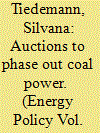

|
|
|
|
|
| Summary/Abstract |
This study assesses the extent to which auctions for compensation payments are a suitable policy instrument for ending coal-fired power generation at minimum cost and thus achieving national climate targets. Germany is the first country to apply such a market-based mechanism. Evaluating the effectiveness and efficiency of the auction, we find that the first five of seven auction rounds will retire 10 GW of coal-fired capacity at a cost of 68 ± 5 EUR/kW, corresponding to an additional carbon price of 2.4 ± 0.2 EUR/tCO2. The possibility of administratively shutting down power plants from 2024 and a decreasing ceiling price have ensured that average compensation payments are well below the ceiling price, and low compared to other policies, even though there was no competition in two of five auction rounds. As the government cancels the freed emission allowances, the policy will result in lower emissions, even though the carbon intensity of the German coal power fleet increased slightly by 2%. Thus, the German auctions can serve as a model for national phase-out strategies in countries with similar institutional frameworks and provide a reference case for integrating conflicting policy objectives into auctions.
|
|
|
|
|
|
|
|
|
|
|
|
|
|
|
|
| 2 |
ID:
125849
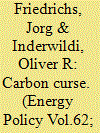

|
|
|
|
|
| Publication |
2013.
|
| Summary/Abstract |
The carbon curse is a new theory, related to but distinct from the resource curse. It states that fossil-fuel rich countries tend to follow more carbon-intensive developmental pathways than [if they were] fossil-fuel poor countries, due to a hitherto unappreciated syndrome of causal mechanisms. First, fuel rich countries emit significant amounts of CO2 in the extraction of fuel and through associated wasteful practices such as gas flaring. Second, easy access to domestic fuel in such countries leads to crowding-out effects for their energy mix and economic structure (for example, abundant oil may displace other fuels from the energy mix and lead to the "Dutch Disease"). Third, fuel abundance weakens the economic incentive to invest in energy efficiency. Fourth, governments in fuel rich countries are under considerable pressure to grant uneconomic fuel consumption subsidies, which further augments the carbon intensity of their economic output. Due to the combined effect of these causal mechanisms, it is genuinely difficult for fuel rich countries to evade carbon-intensive developmental pathways. And yet there are remarkable exceptions like Norway. Such positive outliers indicate that the carbon curse is not destiny when appropriate policies are adopted.
|
|
|
|
|
|
|
|
|
|
|
|
|
|
|
|
| 3 |
ID:
150676
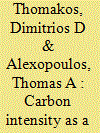

|
|
|
|
|
| Summary/Abstract |
We analyze the relationship between carbon intensity and EPI and find that the informational content of EPI is in large part explainable by the state of economic growth and level of carbon intensity, with the second variable being already an increasing function of emissions and a decreasing function of economic well being. Carbon intensity has the largest explanatory power for EPI rankings and consistently produces the correct, anticipated, negative sign in its relationship to EPI. Second in importance are the renewable energy sources, which also produce consistent results with respect to their impact on the EPI but with much lower explanatory power. Our results suggest that advanced countries should, as they are doing already, implement measures of high quality environmental content while measures for increasing economic growth, while controlling emissions, are appropriate for developing countries. A number of other energy policy implications and the use of new technologies are also discussed in the context of our analysis.
|
|
|
|
|
|
|
|
|
|
|
|
|
|
|
|
| 4 |
ID:
150727
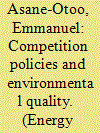

|
|
|
|
|
| Summary/Abstract |
Over the last decades, electricity markets across OECD countries have been subjected to profound structural changes with far-reaching implications on the economy and the environment. This paper investigates the effect of restructuring – changes in entry regulations, the degree of vertical integration and ownership structure – on GHG emissions. The findings show that competition policies – particularly reducing the degree of vertical integration and increasing privatization – correlate negatively with emission intensity. However, the environmental effect of reducing market entry barriers is generally insignificant. Integration of competition and stringent environmental policies are required to reduce GHG emissions and improve environmental quality.
|
|
|
|
|
|
|
|
|
|
|
|
|
|
|
|
| 5 |
ID:
096633
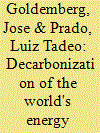

|
|
|
|
|
| Publication |
2010.
|
| Summary/Abstract |
Decarbonizing" the world's energy matrix is the strategy being implemented by most countries to reduce CO2 emissions and thus contribute to achieve the ultimate objectives of the Climate Convention. The evolution of the carbon intensity (Ic=CO2/GDP) in the period 1990-2007 was encouraging but not sufficient to reduce the growth of carbon emission. As a result of COP-15 in Copenhagen these countries (and regions) made pledges that could lead to more reduction: for the United States a 17% reduction in CO2 emissions by 2020 below the level of 2005; for the European Union a 20% reduction in CO2 emissions by 2020 below the 1990 level; for China a 40-45% reduction in the carbon intensity and for India a 20-25% reduction in carbon intensity by 2020. We analyzed the consequences of such pledges and concluded that the expected yearly rate of decrease of the carbon intensity follows basically the "business as usual" trend in the period 1990-2007 and will, in all likelihood, be insufficient to reduce carbon emissions up to 2020.
|
|
|
|
|
|
|
|
|
|
|
|
|
|
|
|
| 6 |
ID:
136227
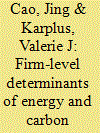

|
|
|
|
|
| Summary/Abstract |
In recent years, China׳s leaders have sought to coordinate official energy intensity reduction targets with new targets for carbon dioxide (CO2) intensity reduction. The Eleventh Five-Year Plan (2006–2010) included for the first time a binding target for energy intensity, while a binding target for CO2 intensity was included later in the Twelfth Five-Year Plan (2011–2015). Using panel data for a sample of industrial firms in China covering 2005 to 2009, we investigate the drivers of energy intensity reduction (measured in terms of direct primary energy use and electricity use) and associated CO2 intensity reduction. Rising electricity prices were associated with decreases in electricity intensity and increases in primary energy intensity, consistent with a substitution effect. Overall, we find that energy intensity reduction by industrial firms during the Eleventh Five-Year Plan translated into more than proportional CO2 intensity reduction because reducing coal use—in direct industrial use as well as in the power sector—was a dominant abatement strategy. If similar dynamics characterize the Twelfth Five-Year Plan (2011–2015), the national 17 percent CO2 intensity reduction target may not be difficult to meet—and the 16 percent energy intensity reduction target may result in significantly greater CO2 intensity reduction.
|
|
|
|
|
|
|
|
|
|
|
|
|
|
|
|
| 7 |
ID:
124624
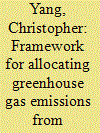

|
|
|
|
|
| Publication |
2013.
|
| Summary/Abstract |
This paper describes a number of different allocation methods for assigning greenhouse gas emissions from electricity generation to charging plug-in electric vehicles. These methods for calculating the carbon intensity of electricity are discussed in terms of merits and drawbacks and are placed into a framework to aid in understanding the relation with other allocation methods. Three independent decisions are used to define these methods (average vs. marginal, aggregate vs. temporally-explicit, and retrospective vs. prospective). This framework is important because the use of different methods can lead to very different carbon intensities and studies or analyses that do not properly identify the methods used can confuse policymakers and stakeholders, especially when compared to other studies using different methods.
|
|
|
|
|
|
|
|
|
|
|
|
|
|
|
|
| 8 |
ID:
105762


|
|
|
|
|
| Publication |
2011.
|
| Summary/Abstract |
Along the lines of the Kaya identity, we perform a decomposition analysis of historical and projected emissions data for China. We compare the results with reduction requirements implied by globally cost-effective mitigation scenarios and official Chinese policy targets. For the years 1971-2000 we find that the impact of high economic growth on emissions was partially compensated by a steady fall in energy intensity. However, the end - and even reversal - of this downward trend, along with a rising carbon intensity of energy, resulted in rapid emission growth during 2000-2007. By applying an innovative enhanced Kaya-decomposition method, we also show how the persistent increase in the use of coal has caused carbon intensity to rise throughout the entire time-horizon of the analysis. These insights are then compared to model scenarios for future energy system developments generated by the ReMIND-R model. The analysis reaffirms China's indispensable role in global efforts to implement any of three exemplary stabilization targets (400, 450, or 500 ppm CO2-only), and underscore the increasing importance of carbon intensity for the more ambitious targets. Finally, we compare China's official targets for energy intensity and carbon intensity of GDP to projections for global cost-effective stabilization scenarios, finding them to be roughly compatible in the short-to-mid-term.
|
|
|
|
|
|
|
|
|
|
|
|
|
|
|
|
| 9 |
ID:
188567
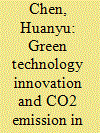

|
|
|
|
|
| Summary/Abstract |
Based on the panel data of 30 provinces in China from 2007 to 2019, this paper investigates the impact of green technology innovation on carbon intensity. Firstly, this paper studies the dynamic evolution and temporal and spatial pattern of China's provincial green technology innovation and carbon intensity. On this basis, the nonlinear spatial Durbin model (SDM) is used to explore the impact of green technology innovation on carbon intensity, and the relevant variables are controlled. The results show that there is a significant spatial agglomeration phenomenon in China's provincial green technology innovation level and carbon intensity. The direct impact of green technological innovation on carbon intensity in local region shows a significant "inverted-U" relationship, that is, when the level of green technological innovation is relatively low, green technological innovation will promote carbon emissions, while when the level of green technological innovation reaches a certain level, this promotion relationship will change into inhibition relationship. From the perspective of interregional spillover effect, green technological innovation also has an “inverted-U″ nonlinear impact on carbon emissions in adjacent regions, that is, the impact of green technological innovation on carbon emissions in adjacent regions is also promoted first and then restrained.
|
|
|
|
|
|
|
|
|
|
|
|
|
|
|
|
| 10 |
ID:
099300
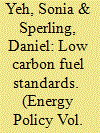

|
|
|
|
|
| Publication |
2010.
|
| Summary/Abstract |
Performance-based low carbon fuel standards (LCFS) of the type implemented in California and being adopted in the European Union, are a promising policy approach for decarbonizing transport fuels and reducing fossil fuel use. This paper examines the efficacy of LCFS policies, along with four major challenges that threaten their effectiveness. These challenges include leakage and shuffling of greenhouse gas (GHG) emissions, impacts on energy security, increased GHG emissions due to global land use conversion (indirect land use changes), and sustainability issues associated with biofuel production. We identify complementary policies that mitigate the severity of these challenges, while noting that some of these challenges are inherent to carbon and alternative fuel policies.
|
|
|
|
|
|
|
|
|
|
|
|
|
|
|
|
| 11 |
ID:
187603
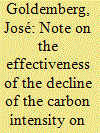

|
|
|
|
|
| Summary/Abstract |
The decline of the carbon intensity (CO2/GDP) in the last few decades in countries around the world is well established but it has been argued that such decline didn't lead to the reduction of global CO2 emissions because it's effect has been offset by GDP growth. We quantified the reduction of CO2 emissions in the period 2000–2018 in 14 countries and the European Union (EU) due to the effectiveness of the carbon intensity changes. In the US, Japan and the EU they led to a strong decline of CO2 emissions and in other countries to reductions of 10–40%. In Iran and Saudi Arabia emissions increased.
|
|
|
|
|
|
|
|
|
|
|
|
|
|
|
|
| 12 |
ID:
107628


|
|
|
|
|
| Publication |
2011.
|
| Summary/Abstract |
Historical time trends indicate that both carbon and energy intensity have declined in the United States over the last several decades, while economic performance, as measured by per capita GSP, has improved. This observation indicates that it may be possible to reduce carbon intensity without a reduction in economic performance. This paper assesses using panel analysis, the empirical relationship between carbon emissions intensity and economic performance, and examines the direction of causality between the two variables. Data for the analysis covered 48 states, excluding Hawaii, Alaska, and Washington DC, from 1980 to 2000. The results indicate significant bi-directional relationship between carbon emissions intensity and state economic performance, both using an aggregate indicator for carbon emissions intensity, decomposed using Laspeyres indexes and disaggregated by sector. This implies that it should be possible to implement statewide and sector-specific policies to reduce energy and carbon intensity and at the same time improve economic performance.
|
|
|
|
|
|
|
|
|
|
|
|
|
|
|
|
| 13 |
ID:
171435
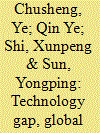

|
|
|
|
|
| Summary/Abstract |
The technological progress of a country may mean that its technology gap compared to the frontier has changed, which will induce a change in its positioning in the global value chain and affect its carbon intensity. Using paten data, Input Output Database and the Global Value Chain Index, we employ systematic Generalized Method of Moments, quantile regression with panel data and multilevel mediation analysis to measure empirically the impact of the technology gap on carbon intensity and positioning on the global value chain. The empirical analysis shows that narrowing the technology gap will reduce significantly a country's carbon intensity. Further, the effect of the technology gap on carbon intensity is more pronounced on industries with higher carbon intensity. The mechanism test using the mediation effect model proves that the impact of the technology gap on carbon intensity is achieved by changing in the position of global value chain. The findings suggest that a country's carbon intensity performance is not only affected by its own technological progress, but also by global frontiers. Therefore, a country should not only pay attention to its own technological progress but also to the development of global frontier technologies and speed of technological progress.
|
|
|
|
|
|
|
|
|
|
|
|
|
|
|
|
|
|
|
|
|